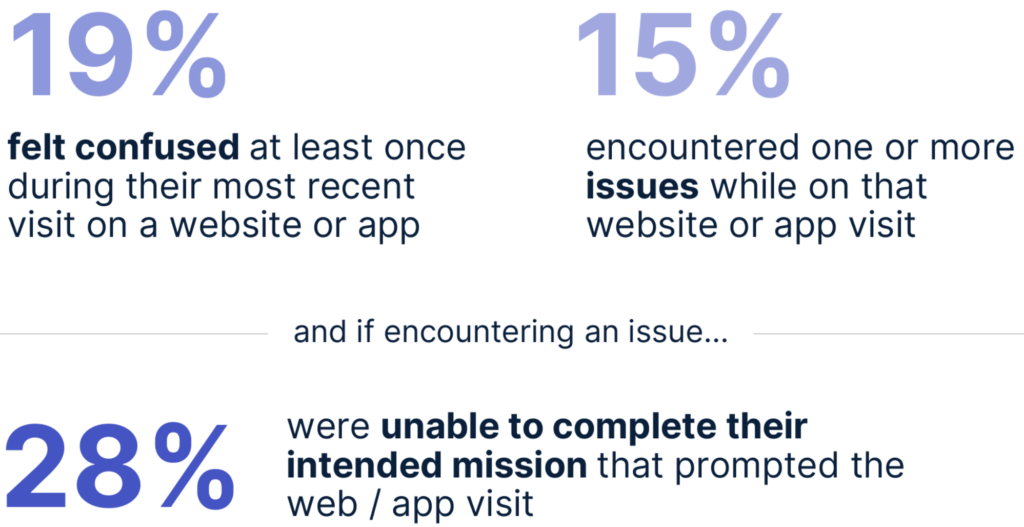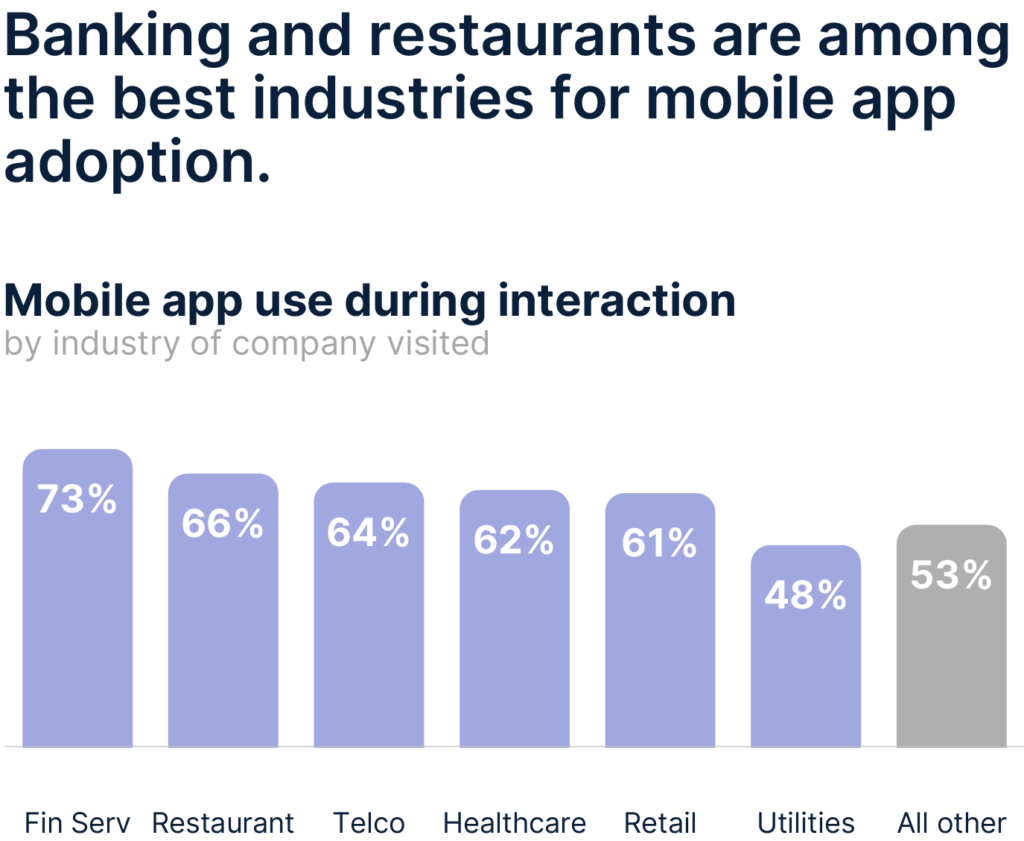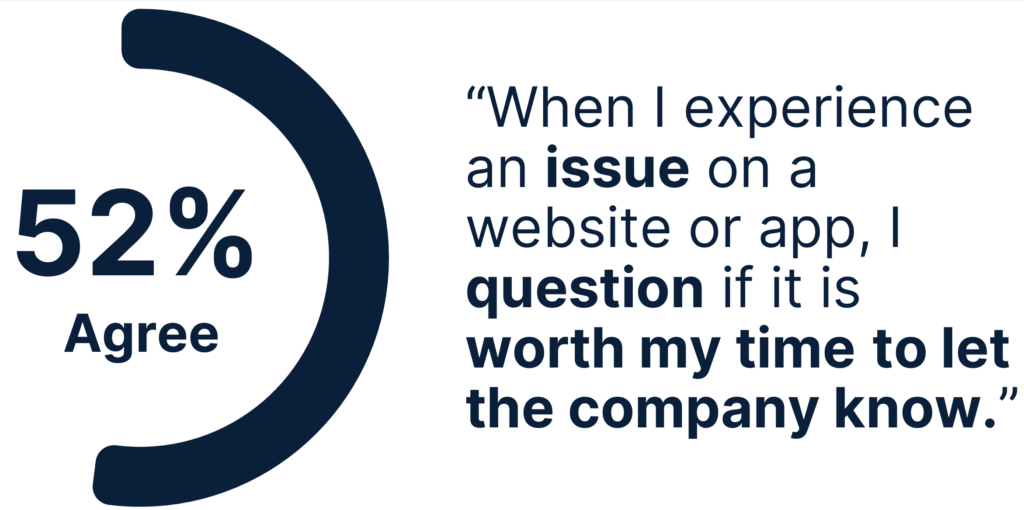Digital Trends in CX: Recent Shifts in App and Website User Experiences
February 13, 2025
Digital Experience
New research reveals the top digital trends shaping the website user experience, app user experience, and overall customer experience.
For today’s omnichannel, digital-first consumers, apps and websites are the primary — and preferred — channels that customers use to interact with businesses. Because of this, they’re hugely influential in shaping the user journey, with digital touchpoints having the power to make or break customer loyalty.
That’s why, more than ever, companies need to understand the app and website user experience and how the digital landscape is evolving.
For real-world insights, Medallia Market Research conducted a survey of 2,002 U.S. consumers to learn more about their digital experiences and how they impact the overall cross-channel customer experience. Our report, Latest Findings on the Digital Customer Experience, offers a comprehensive overview and analysis of our study’s results. Here are the highlights.
Top 10 Consumer Digital Trends in 2025
1. High-quality app and website user experiences can attract customers, while bad ones often drive them away.
In fact, the majority of consumers (58%) say that at least once, they have chosen a competitor due to the lack of quality of a brand website or mobile app, while a similar share (51%) say that in the past, they have stopped being a customer of a company because they encountered too many difficulties using their website or mobile app.

Among the digital trends we’re seeing in 2025 is that consumers are most likely to abandon a brand’s website or app due to data security or privacy issues, the website or app malfunctioning, and not being able to find what they’re looking for when searching or browsing.
2. There’s a lot of room for companies to improve the digital experience.
About 1 in 5 consumers tell us they felt confused at least once during their most recent website or app user experience, and 15% say they encountered one or more issues while on that website or app visit. For those that encountered issues, more than 1 in 4 (28%) report being unable to complete their customer journeys.

This is one of the digital trends that brands can’t afford to ignore in 2025 because, according to our findings, when customers have an issue, they’re more than two times as likely to be unsatisfied with their visit.
Areas of the digital customer experience that have the greatest room for improvement include downloading documents, content, or applications; filling out a form or typing in information; and using a search bar or filters.
3. When customers encounter broken app or website user experiences, that puts pressure on other channels.
About 1 in 4 consumers report that when they had an issue with a brand during their last interaction, they ended up contacting customer service (27%), visiting again on a non-digital channel (e.g. in-person, calling on phone) (25%), and visiting again on a different digital channel (e.g. web, app, social) (21%).
4. Apps are becoming the preferred digital channel.
Another key 2025 digital trend brands need to keep on their radar is the dominance of apps as the preferred digital touchpoint. Consumers are more likely to report using a brand’s app versus their website (57% to 44%) — and they are even more likely to say that the app experience is their preferred digital channel versus the website experience (70% vs. 42%).
5. Frequent customers in industries like financial services and restaurants are likelier to prefer apps over websites.
App visits are usually driven more by the user than external prompts, meaning brands must make app features compelling to spark the choice. Fortunately for app evangelists, consumers recognize that the app experience is better than a website in virtually every attribute.

6. Seventy percent of consumers report that they don’t leave any feedback about their digital experiences.
Not only that, consumers tell us that they’re 22% less likely to leave feedback about their experience if they have an issue that’s unresolved versus when they have an issue that eventually gets resolved, meaning the voices of customers potentially encountering the biggest challenges aren’t as likely to be heard. Fifty-two percent wonder if it’s worth letting the company know about the issue.

It’s time for brands that are relying on customer surveys as one of their main ways of gathering insights about their app and website user experience to rethink that strategy.
7. In 2025, a key imperative for brands will be adopting other digital customer experience monitoring strategies and solutions.
Tools like digital experience analytics can help teams understand what’s happening for 100% of website and app users across their journeys rather than just the percentage of users who leave feedback. These digital behavioral intelligence capabilities track when customers are encountering issues across websites and apps and can help pinpoint where users are dropping off in the conversion funnel. These real-time insights can enable companies to intervene quickly with the appropriate next-best action, whether that’s by offering live chat support or triggering a discount or promotion to be displayed.
This is in line with what customers want brands to do. Most consumers (56%) say they want companies to know they’re having a problem using their website or app without having to tell the business about the issue. And a similar share (50%) say they’re comfortable with customer service teams having access to data about how they clicked or navigated through a website or app so they can help customers with any issues they encounter.
8. Shopper customer journeys are evolving thanks to social media and app in-store modes.
More than half of consumers (59%) say they’ve purchased a product through a social media platform and a similar portion (55%) say they have used the “in-store mode” on a company’s mobile app while at a company’s physical location.
9. A sizable percentage of consumers say AI is influencing their website user journeys.
More than half of consumers say they’ve used a conversational artificial intelligence tool (like ChatGPT or Gemini) before and nearly 4 in 10 say they’ve ended up on a website because of information provided by AI tools (like ChatGPT or Gemini).
10. But consumers say app in-store mode is the digital innovation that’s most likely to significantly enhance their user experience.
Ahead of other digital features like artificial intelligence agents (ranked #4), social commerce (ranked #3), and generative search (ranked #2), consumers are most likely to say having an in-store mode available in brands’ mobile apps would enhance their future experiences significantly.
Embracing Better App and Web User Experiences for Consumers
Success today requires delivering an exceptional digital experience, particularly on mobile, where consumers are more likely to interact (and prefer to interact) with brands.
Businesses that excel have the chance to strengthen customer loyalty and gain market share, while those that fail to meet consumer expectations could lose customers to the competition.
The reality is that most brands likely have room to improve their digital channels. About 15 to 20% of consumers report experiencing confusion or issues during their last website or app experience, challenges that ultimately prevented some journeys from being completed. These kinds of problems have a ripple effect across the overall customer experience, impacting the contact center, social media, and in-person touchpoints.
Because the vast majority of consumers aren’t providing feedback about their digital experiences, brands need to invest in new, advanced methods of tracking what’s happening on their apps and websites in real time.
Over the next year, social media, AI, and app innovations will reshape how consumers discover and transact with businesses. Now is the time to get ahead of adopting strategies for managing and enhancing these new and evolving experiences.
Check out our report, Latest Findings on the Digital Customer Experience, for the latest consumer insights into digital experiences.











